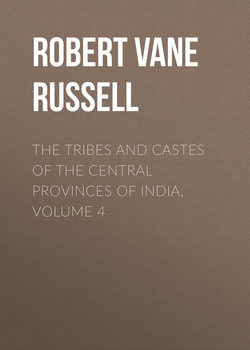Читать книгу The Tribes and Castes of the Central Provinces of India, Volume 4 - Robert Vane Russell - Страница 44
Part II
Articles on Castes and Tribes
Kumhār—Yemkala
Vol. IV
Kurmi
5. Marriage rules. Betrothal
ОглавлениеMarriage is prohibited between members of the same section and between first and second cousins on the mother’s side. But the Chandnāhe Kurmis permit the wedding of a brother’s daughter to a sister’s son. Most Kurmis forbid a man to marry his wife’s sister during her lifetime. The Chhattīsgarh Kurmis have the practice of exchanging girls between two families. There is usually no objection to marriage on account of religious differences within the pale of Hinduism, but the difficulty of a union between a member of a Vaishnava sect who abstains from flesh and liquor, and a partner who does not, is felt and expressed in the following saying:
Vaishnava purush avaishnava nāri
Unt beil ki jot bichāri,
or ‘A Vaishnava husband with a non-Vaishnava wife is like a camel yoked with a bullock.’ Muhammadans and Christians are not retained in the caste. Girls are usually wedded between nine and eleven, but well-to-do Kurmis like other agriculturists, sometimes marry their daughters when only a few months old. The people say that when a Kurmi gets rich he will do three things: marry his daughters very young and with great display, build a fine house, and buy the best bullocks he can afford. The second and third methods of spending his money are very sensible, whatever may be thought of the first. No penalty is imposed for allowing a girl to exceed the age of puberty before marriage. Boys are married between nine and fifteen years, but the tendency is towards the postponement of the ceremony. The boy’s father goes and asks for a bride and says to the girl’s father, ‘I have placed my son with you,’ that is, given him in adoption; if the match be acceptable the girl’s father replies, ‘Yes, I will give my daughter to collect cowdung for you’; to which the boy’s father responds, ‘I will hold her as the apple of my eye.’ Then the girl’s father sends the barber and the Brāhman to the boy’s house, carrying a rupee and a cocoanut. The boy’s relatives return the visit and perform the ‘God bharna,’ or ‘Filling the lap of the girl.’ They take some sweetmeats, a rupee and a cocoanut, and place them in the girl’s lap, this being meant to induce fertility. The ceremony of betrothal succeeds, when the couple are seated together on a wooden plank and touch the feet of the guests and are blessed by them. The auspicious date of the wedding is fixed by the Brāhman and intimation is given to the boy’s family through the lagan or formal invitation, which is sent on a paper coloured yellow with powdered rice and turmeric. A bride-price is paid, which in the case of well-to-do families may amount to as much as Rs. 100 to Rs. 400.
